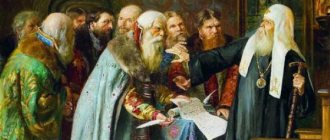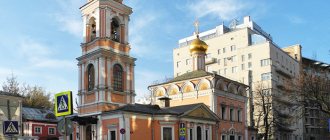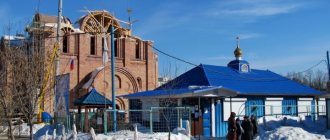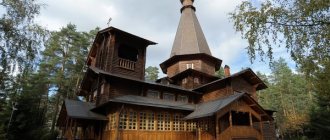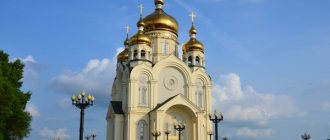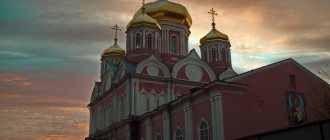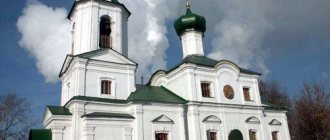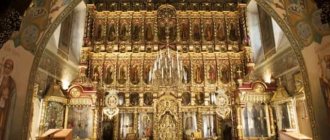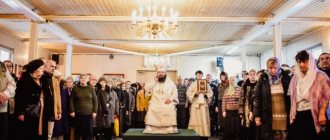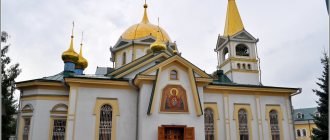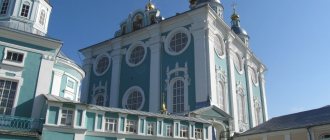The Church of St. Nicholas of Myra in Zelenograd is the oldest church in the Zelenograd deanery, built at the end of the 18th century. The majestic structure with unique architecture on the outside and luxurious decoration on the inside attracts parishioners with its services and shrines.
Church of St. Nicholas of Myra in Zelenograd
Historical events
The first city church was Nikolsky, which was built in 1989. After some time, it became clear that this church was not enough for a large microdistrict. Therefore, it was decided to build another temple on the outskirts of the city.
The Philaret Church in Zelenograd was found thanks to the director of the “Small Academy of Harmony”. In 1993, the director of the educational institution submitted a petition to higher authorities to build a church for children attending an Orthodox school. The petition found unexpected support from the administration and the diocese.
The Philaret Church in Zelenograd is built of wood
The church was built in record time. At the beginning of winter 1994, construction was already completed. In January 1995, the new church was consecrated in honor of Metropolitan Philaret of Moscow, and was added to the Cathedral of St. Nicholas in Zelenograd.
In the summer of 1999, there was a fire in the church. It began at night in the temple refectory. The flame instantly destroyed almost the entire building. Firefighters put out the fire, but the entire interior of the church burned and the wooden frame of the building was badly damaged. It was possible to save only the altar part of the building and part of the iconostasis.
For almost a year after this, the service was held in a large army tent on the territory belonging to the burnt church.
In 2000, the cathedral was rebuilt and services resumed in April. The new building was built on the old foundation, but this time the building was much wider, and a gallery was added to it.
Since 2021, the temple has been assigned to the Patriarchal Compound in honor of the icon of the Mother of God “Quick to Hear.” In the summer of 2021, external renovations of the building were carried out; internal work in the church is carried out every summer.
Now, next to the wooden building, work has begun on the construction of a new large complex. The temple complex will consist of a cathedral built in the Byzantine style, parish premises and a bell tower. All buildings will be connected to each other by passages.
The wooden Philaret church and school will also be included in the ensemble. It is planned to open a spiritual and educational center here.
Parishioners offer weekly prayers for the construction of a new church.
War and the Bell Tower
In 1941, the abandoned St. Nicholas Church again had the opportunity to serve the fatherland. In the winter of 1941, the Germans broke through the village of Matushkino - fascist tanks ended up on the Moscow-Leningrad highway. The firing positions of our troops were located near the village of Rzhavki, and the command was in the Chashnikovo area, where they controlled battery fire from the infantry locations.
On November 30, the Nazis managed to cut off the artillery commanders from their firing positions. All the batteries seemed to go blind and could no longer fire, and the commanders could no longer control them. German tanks and infantry rushed to the firing positions. Commissar Alexey Penkov recalled this battle: on that day he was 300 meters from the firing positions, in the bell tower of the St. Nicholas Church, where a communications point was equipped. From there, Penkov adjusted the fire of our batteries - howitzers of the 7th Guards Division, and they shot at German tanks and infantry with direct fire. Half a century later, the iron “basket” where Commissioner Penkov was located was discovered during the restoration of the temple.
After the war, by the beginning of the school year in 1947, a school was reopened on the territory of St. Nicholas Church. A second floor was added to the former one-story building of the old zemstvo school - the new Rzhavskaya school became a seven-year school. Children from the villages of Elino, Matushkino, Savelka, and Rzhavka studied there. As priest Mikhail Ilyin told Zelenograd.ru, when young teachers were sent to the new school, they were going to settle them in... the church bell tower. However, by that time bats had already chosen her, and the teachers flatly refused such a neighborhood.
Then in 1948 the authorities decided to blow up the “useless” bell tower. They brought up a tractor and pulled the cables to give her direction as she fell. And yet, falling, the bell tower damaged the roofs of both buildings of the former almshouse.
Local historian Igor Bystrov gives details of the destruction of the bell tower from the words of a native of the village of Rzhavka, Pyotr Nikolaevich Ershov, in his essay “The Old Churchyard”:
“...When they began to destroy the church bell tower, old women from the St. Nicholas parish gathered and began to scold and curse the destroyers. They tied a cable around the bell tower of the St. Nicholas Church and began to destroy it with a tractor. Not on the first try, with difficulty, but they still succeeded. They say that the authorities stole the marble tombstones of the Dolgorukov princes for the graves of their relatives, having previously erased the original inscriptions. And the fence of the Nikolskaya Church was allegedly moved to Khimki (at that time the village of Nikolskoye belonged to the Khimki district), and now this fence frames the building of the Khimki City Council.”
St. Nicholas Church stood abandoned for half a century. Over the years, there has been a lot of things in it: grain was sorted there and vegetables were stored, State Circus workshops and a quarantine point for animals were located there. In the 1970s, buildings for the Iskra pioneer camp for Zelenograd children were built next to the church. The camp operated year-round - both summer and winter. It was separated from the territory of the church and the bell tower building without tiers by a fence. According to the recollections of old-timers, the camp infirmary was located in the wings of the bell tower.
Architecture, appearance
Both the first and the rebuilt temple were created according to the design of the chief city architect I.A. Pokrovsky in the spirit of Russian wooden architecture. The work was supervised by N. Deryabin. The building is designed in the style of cage churches, the construction of which was typical of the first Russian houses of worship, as well as the church architecture of the Russian North in the 19th century.
These buildings were not very different from an ordinary peasant hut. They are a small rectangular frame or cage with a gable roof; on the ridge of the roof there is a blind drum ending in a small dome with one cross.
On the eastern side there is a pentagonal apse with a small dome, on the west there is a small refectory. This building differs from the ancient Russian cage church only in its high basement foundation and the gallery-promenade, which encircles the building on three sides. Two porches lead to the gallery. The building is decorated with carved ornaments on pillars and a drum.
Instead of a bell tower, there is a small belfry in the courtyard. The rather extensive area has several buildings, which are surrounded by a wooden fence with carved gates. In some architectural elements, the church continues the traditions of wooden temple architecture of the Moscow region of the 15th - 18th centuries. It is the first wooden church built on the territory of Moscow after the revolution.
Interior decoration
The interior decoration of the temple is very modest. It's quite cramped inside. The wooden log walls are decorated with numerous icons. The iconostasis covering the entrance to the altar consists of three tiers: local, festive and deesis.
According to the church rite, the first tier is occupied by icons of Christ and the Mother of God, located on both sides of the royal doors, here is the image of Metropolitan Philaret of Moscow, in the second row are the bowed figures of the apostles facing the image of Christ. The iconostasis is made entirely of wood.
Shrines
Zelenograd especially honors the Philaret Church for the reason that the memory of two great clerics is immortalized there. Two thrones were created in it. One is in honor of Metropolitan Philaret of Moscow, the second one is dedicated to Metropolitan Alexy II.
Icon of St. Philaret
The main shrine of the church is the icon of Metropolitan Philaret with a particle of his relics. It is not without reason that the temple bears the name of the Metropolitan. The saint was a representative of the intellectual elite of the 19th century. Filaret became famous as a cleric who devoted many years of his life to education.
The image is credited with a special gift that he possessed during his lifetime.
Saint:
- eased people's suffering;
- healed from diseases;
- directed on the right path;
- protected from misfortunes.
In front of the image of the saint they pray for health, for family prosperity, for healing.
Particles of the relics of St. Neil of Stolobensky
The church contains particles of the relics of St. Neil Stolobensky.
The monk lived a long hermit life on Fr. Seliger, near the city of Ostashkov, spending all his time in prayer. For his humility, he was canonized. His incorruptible relics were found during the construction of the temple, in the place where the saint’s cell was located.
They pray in front of the relics to strengthen faith, for guidance on the true path, for healing for eye diseases and future long journeys, especially sea ones. According to legend, cases of healing of those praying at the relics of the monk were known.
Icon of the Mother of God “Quick to Hear”
Another revered icon of the temple was the image of the Mother of God “Quick to Hear.” The image is considered miraculous. This is an unusually revered icon that helps in difficult situations.
People turn to the image for help before childbirth, for healing children, in difficult life situations.
Thanks to the miraculous power of the icon:
- the blind became sighted;
- the lame began to move;
- those considered dead were returning from captivity;
- people remained alive during disasters;
- those possessed by demons were cured.
The image of the Mother of God is depicted according to the Hodegetria type. The child sits on the left hand of the Mother of God, blesses with his right hand, and holds a scroll in his left hand. The right heel of the Baby is facing those praying. Later the Saint was depicted wearing a crown.
The original of the Mother of God “Quick to Hear” is kept in the holy city of Athos, in one of the monasteries. Here, according to legend, in the 10th century. the image of the Saint was painted.
There are numerous copies of “Quick to Hear” in many cities:
- Jerusalem;
- Petrozavodsk;
- Moscow;
- Arkhangelsk;
- Chelyabinsk.
It should be noted that a particularly valuable image of the Saint is kept in the Cathedral of St. Nicholas in Biryulyovo. In honor of the image, the temple on Khodynka Field was consecrated.
There is a Moscow copy of the icon in the Athos Chapel, which is located on Kitay-Gorod near the St. Nicholas Gate. According to legend, a widow was healed there. The lady had seizures of demons, which occurred on holy days, as well as during prayers, services and conversations about God. Her relatives advised her to kneel before the image of the “Quick to Hear.” When the prayer service was held, the widow was cured.
The “Quick to Hear” icon survived two fires and remained intact.
In the second extension there is an icon of St. Alexis II.
Schedule of services in Zelenograd for Christmas
Good to know 01/06/2018 11:00
Church of St. Sergius of Radonezh in the 16th microdistrict. Archive photo "Zelenograd24"
The Russian Orthodox Church celebrates the Nativity of Christ on the night of January 6-7. Festive services are held on both of these days. The day of January 6 is called the Eve of the Nativity of Christ (Christmas Eve), January 7 is the Nativity of the Lord God and our Savior Jesus Christ.
Divine services in Zelenograd churches will be held:
St. Nicholas Church (Church of St. Nicholas of Myra)
6th January
- 9:00 – Liturgy, vespers.
- 16:00 – All-night vigil.
Jan. 7
- 0:00 – 1st Liturgy.
- 7:00 – 2nd Liturgy.
- 10:00 – 3rd Liturgy.
- 17:00 – Vespers.
Philaret Church (Church of St. Philaret of Moscow)
6th January
- 9:00 – Clock. Liturgy. Ninth hour. Great Vespers.
- 15:00 – Confession.
- 16:00 – All-night vigil.
- 22:00 – Confession.
Jan. 7
- 0:00 – Clock. Liturgy.
- 9:40 – Clock. Liturgy.
- 16:00 – Vespers with an akathist to the Most Holy Theotokos in honor of Her icon “Quick to Hear.”
Temple of Alexander Nevsky (Church of the Holy Blessed Grand Duke Alexander Nevsky)
6th January
- 8:30 – Funeral litany.
- 9:00 – Liturgy. Great Supper.
- 16:00 – Confession.
- 17:00 – All-night vigil.
- 23:00 – Matins with polyeleos (singing), 1st hour.
Jan. 7
- 0:00 – Liturgy.
- 8:00-20:00 – The temple is open to the public.
- 9:00 – Water Blessing Prayer Service.
- 16:00 – Matins, 1st hour.
Temple-chapel of St. Sergius of Radonezh (Temple of St. Sergius of Radonezh)
6th January
- 9:00 – Liturgy, vespers.
- 16:00 – All-night vigil.
Jan. 7
- 0:00 – Liturgy.
- 17:00 – Vespers.
St. George's Church (Church of the Holy Great Martyr George the Victorious)
6th January
- 9:00 – Liturgy, vespers.
- 17:00 – All-night vigil.
Jan. 7
- 0:00 – Liturgy.
Let us remind you that on the night of Christmas, from January 6 to 7, buses on routes No. 400 “staged” and No. 400T will operate until 3 am. For parishioners of Zelenograd churches, buses will be provided after the end of the Christmas service: buses No. 9, 11, 29 will be waiting for them at the Philaret Church, and buses No. 1, 2, 12, 19 will be waiting for them at the St. Nicholas Church.
| Tags: holiday, Christmas, services, schedule, religion, Orthodoxy |
For those who do not have enough time to attend church, but really like listening to songs, watching performances, follow the link and online you will see a large number of videos, etc. All details on bogvideo.com. advertising
| If you find an error in the text, highlight it and press Ctrl + Enter |
[ ]
Opening hours and schedule of services
Philaret Church is open daily from 8.00 to 20.00. The morning liturgy begins at 8.00, followed by a prayer service at 16.00, and the evening liturgy at 17.00. On holidays the morning service begins at 6.40. This schedule is very important for Zelenograd, since city residents have difficulty getting here at earlier hours.
Patronal holidays:
| date | In honor of which saint or icon |
| 18.10 and 02.12 | Memorial Day of St. Philaret |
| 25.02, 02.06 and 18.10 | In the name of St. Alexy |
| 22.11 | Icons of the Mother of God “Quick to Hear” |
Prayers are held twice a week:
- On Thursdays - for addicts: about deliverance.
- On Friday - for pregnant women: about the successful course of pregnancy and early childbirth. After the service, expectant mothers are given professional discussions on issues of pregnancy, childbirth, breastfeeding and raising a baby.
Parish activities of the temple
In addition to divine services, the performance of sacraments and parish services, the church hosts active social activities:
- Catechetical conversations on the eve of the Sacraments.
- Theology courses for adults.
- Znamenny and youth choirs.
- Studying the Church Slavonic language.
- Help from psychologists and lawyers.
- Charity service.
- Studio of sewing and patchwork fabric crafts.
- School of floristry.
- Photo studio circle and film lovers club.
- Nordic walking, physical therapy classes.
- Pilgrimage trips to holy places.
Children's Sunday school
The doors of the school opened in September 2021. Currently, classes are held here for children from 3 to 14 years old. A short-term group for children has been opened on the basis of the Sunday school. Here they are given classes in speech therapy, the Montessori program, and classes on developing fine motor skills.
The GKP has a speech therapy group for children 4-7 years old, in which experienced speech pathologists and teachers work with children. Six-year-olds are prepared for school using the Classical School program. In classes, children study grammar, speech development, the world around them, and mathematics.
Every month solemn congratulations are held for birthday people.
Older children are engaged in drawing, arts and crafts, mathematics, Russian and English. There is a patriotic education circle “Alekseevskaya squad”. The Gornitsa studio recently opened its doors. Here children and their parents spend holidays in Russian traditions, drinking tea.
Filaretovsky Church (Zelenograd is in dire need of objects of social and educational work) is one of the platforms that carries out cultural and educational activities. During the holidays, competitions, concerts, congratulations with gifts for parishioners and traditional tea drinking are held here.
A more detailed schedule of classes and services for each month can be found on the website: https://dobrohram.ru/kontakty/.
Social work of residents and parishioners
The Zelenograd monastery consists of a temple, a Sunday school library and nuns' cells.
The 250-year-old shrine is the pride of the city and its emblem. For 25 years, adults and children have been learning the Law of God with Sunday school teachers.
Important! The St. Nicholas Shrine is truly a people's monastery, for many city social institutions are under its care.
Whole groups of volunteers from parishioners work here to help clean the apartments of weak and sick Christians. They prepare for Orthodox holidays and help in the rehabilitation center in working with disabled children.
Directions
The temple is located in the 11th microdistrict of Zelenograd and is easy to get to.
By your own car
To drive your own car to the Philaret Church, just enter the coordinates: 55.99146863646352; 37.180781364440925 or actual address.
Metro
From the Khovrino metro station you need to take minibus No. 476 and get to the 12th microdistrict stop. From the stop, walk to the church.
From the Pyatnitskoye Shosse metro station there is bus route No. 400k. You need to get to the stop. bldg. 1538. There you need to change to buses No. 32 or 15. Go to the stop. “Oktyabrskaya”, and then go to the other side of the street and go to the intersection of Panfilovsky Prospekt with Filaretovskaya Street, there turn left to the temple.
By railway
The train goes to the station. Kryukovo from Leningradsky station. This is the Komsomolskaya metro station. From the railway station take buses No. 1, 10, 12 to the stop. "Oktyabrskaya". Further from the underground passage the route is the same.
Hotels in the area
In general, the city has many hotels, apartments, and hospices of any price category (starting from 500 rubles and above).
Specifically, not far from the temple, which is located in the 11th microdistrict of the city, there are three apartments:
- "Apartments near the school lake." Panfilovsky Avenue 1003
- This is a one-room apartment. Price per night from 2500 rub.
- "Apartments on Kryukovskaya." Kryukovskaya sq. K834B. One-room apartment. Price per night from 1900 rub.
- "Apartments on Gogol" st. Gogol, cor. 1013
The two-star Record Hotel is located 2 km from the temple. Price per day from 3700 rub.
At a distance of 3 km there are two more hotels: CM's Hotel provides rooms at prices starting from 2151 per night, the Micron Hotel - 2300 per night.
January 15 of each year is the memorable day of the consecration of the Philaret Church in Zelenograd by Patriarch Alexy 2. This is the first church in the world dedicated to St. Philaret after his glorification as a saint in December 1994.
Patronal holidays
The Orthodox Church honors the memory of the Miracle Worker of Myra.
Divine service at St. Nicholas Church in Zelenograd
Thousands of parishioners gather in the temple complex of Zelenograd for patronal feasts:
- December 19 is the day when the holy saint rested in the Lord;
- May 22 - the holy relics arrived in the city of Bari.
Every year on August 11, during the service, the Nativity of the Wonderworker is mentioned.
Every Thursday, icons of the Holy Wonderworker are venerated, of which there are several in the history of Orthodoxy.
